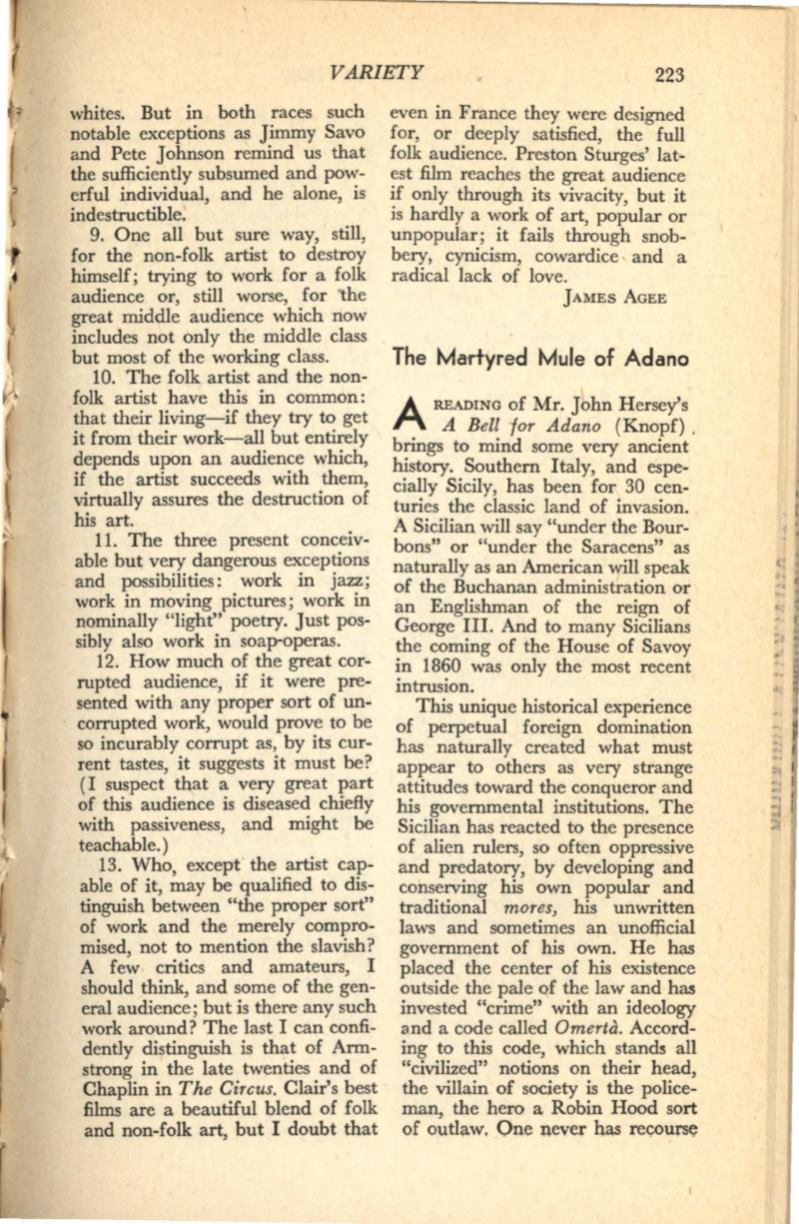
•
I
VARIETY
223
whites. But in both races such
notable exceptions as Jimmy Savo
and Pete Johnson remind us that
the sufficiently subsumed and pow–
erful individual, and he alone, is
indestructible.
9. One all but sure way, still,
for the non-folk artist to destroy
himself; trying to work for a folk
audience or, still worse, for "the
great middle audience which now
includes not only the middle class
but most of the working class.
10. The folk artist and the non–
folk artist have this in common:
that their living-if they try to get
it from their work-all but entirely
depends upon an audience which,
if the artist succeeds with them,
virtually assures the destruction of
his art.
11. The three present conceiv–
able but very dangerous exceptions
and possibilities: work in jazz;
work in moving pictures; work
in
nominally "light" poetry. Just pos–
sibly also work in soap-operas.
12. How much of the great cor–
rupted audience, if it were pre–
sented with any proper sort of un–
corrupted work, would prove to be
so incurably corrupt as, by its cur–
rent tastes, it suggests it must be?
(I suspect that a very great part
of this audience is diseased chiefly
with passiveness, and might be
teachable.)
13. Who except' the artist cap–
able of it,
~y
be qualified to dis–
tinguish between "the proper sort"
of work and the merely compro–
mised, not to mention the slavish?
A few critics and amateurs, I
should think, and some of the gen–
eral audience; but is there any such
work around? The last I can confi–
dently distinguish is that of
Arm–
strong in the late twenties and of
Chaplin in
The Circus.
Clair's best
films are a beautiful blend of folk
and non-folk art, but I doubt that
even in France they were designed
for, or deeply satisfied, the full
folk audience. Preston Sturges' lat–
est film reaches the great audience
if only through its vivacity, but it
is hardly a work of art, popular or
unpopular; it fails through snob–
bery, cynicism, cowardice and a
radical lack of love.
JAMES AGEE
The Martyred Mule of Adano
A
READING
of Mr. John Hersey's
A Bell for Adano
(Knopf) .
brings to mind some very ancient
history. Southern Italy, and espe–
cially Sicily, has been for 30 cen–
turies the classic land of invasion.
A Sicilian will say "under the Bour–
bons" or "under the Saracens" as
naturally as an American will speak
of the Buchanan administration or
an Englishman of the reign of
George III. And to many Sicilians
the coming of the House of Savoy
in 1860 was only the most recent
intrusion.
This unique historical experience
of perpetual foreign domination
has naturally created what must
appear to others as very strange
attitudes toward the conqueror and
his governmental institutions. The
Sicilian has reacted to the presence
of alien rulers, so often oppressive
and predatory, by developing and
conserving his own popular and
traditional
mores,
his unwritten
laws and sometimes an unofficial
government of his own. He has
placed the center of his existence
outside the pale of the law and has
invested "crime" with an ideology
and a code called
Omerta.
Accord–
ing to this code, which stands all
"civilized" notions on their head,
the villain of society is the police–
man, the hero a Robin Hood sort
of outlaw. One never
h<~S
rec;ourse


